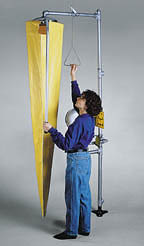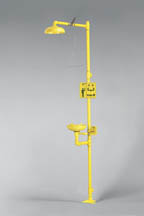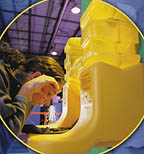In 1998, additions and clarifications were made to the ANSI Z358.1 standard for emergency eyewash and shower equipment that have had an impact on every end user and installer of these products. This voluntary standard is commonly accepted for use in the selection, installation and maintenance of emergency fixtures. It is understood that OSHA uses the requirements from the ANSI standard for compliance with the agency's regulation 29 CFR 1910.151 (c), even though it is not specified in its Code of Federal Regulations. Therefore, it is important to understand the standard to ensure compliance when selecting and installing emergency equipment.
When the standard was revised in 1998, additional information and clarification was added regarding the performance, installation, maintenance, and use of the emergency fixture. This document will focus on 10 important issues, and it is recommended that the installer keep a copy of the standard and any local codes on hand for reference.

Key Changes in the 1998 Revision
1. Spray Pattern. In the 1990 version, ANSI Z358.1 stated that the center of the spray pattern for a drench shower be located at least 16" from any obstruction. There was some concern that the eyewash portion of a combination shower/eyewash fixture could be viewed as an obstruction, so the 1998 update clarified that the eyewash portion of a combination unit is not considered an obstruction.
2. Location.
The distance to reach the emergency fixture was identified as being in an accessible location that requires no more than 10 seconds to reach and within a travel distance no greater than 100 feet in the 1990 version. The 1998 update included the 10 seconds to reach provision, but added that the equipment must be located on the same level as the hazard and that the path of travel should be free of obstructions. In other words, the user of the equipment cannot be expected to traverse an obstacle course or travel up/down stairs or ramps in order to reach the emergency equipment that can provide them with relief.3. Signs and Lighting.
In regards to signs and lighting, the 1990 version noted that each emergency fixture should be identified with a highly visible sign and that the area around the emergency shower be well lighted. The update stated that not only should the area be well lit and that the sign be highly visible, but that the sign should also be positioned so that the sign is easily visible within the areas served by the emergency equipment.
4. Shut-Off Valves.
Another important addition related to shut off valves. The 1990 version stated that the emergency fixture should be connected to a sufficient supply of flushing fluid. The 1998 update included this information along with the statement that if there are shut-off valves on the supply line for any reason, there must be provisions made to prevent unauthorized shut off. The best way to ensure the supply line is not accidentally shut off is to install a lockout device at that valve location.5. Simultaneous Operation.
There was a second change that also had to do with the supply of flushing fluid. In the 1990 version, the section on combination eyewash/shower fixtures stated that while individual conditions may vary, it was not necessary for all components to operate simultaneously. In the 1998 update, the combination fixture needed to be connected to a system capable of supplying the requirements of each component when they are operated simultaneously. It further states that the components need to be positioned so that the same user can operate both components. Therefore, if a user should be splashed in the face and body, that user could wash out the eyes while drenching the body.